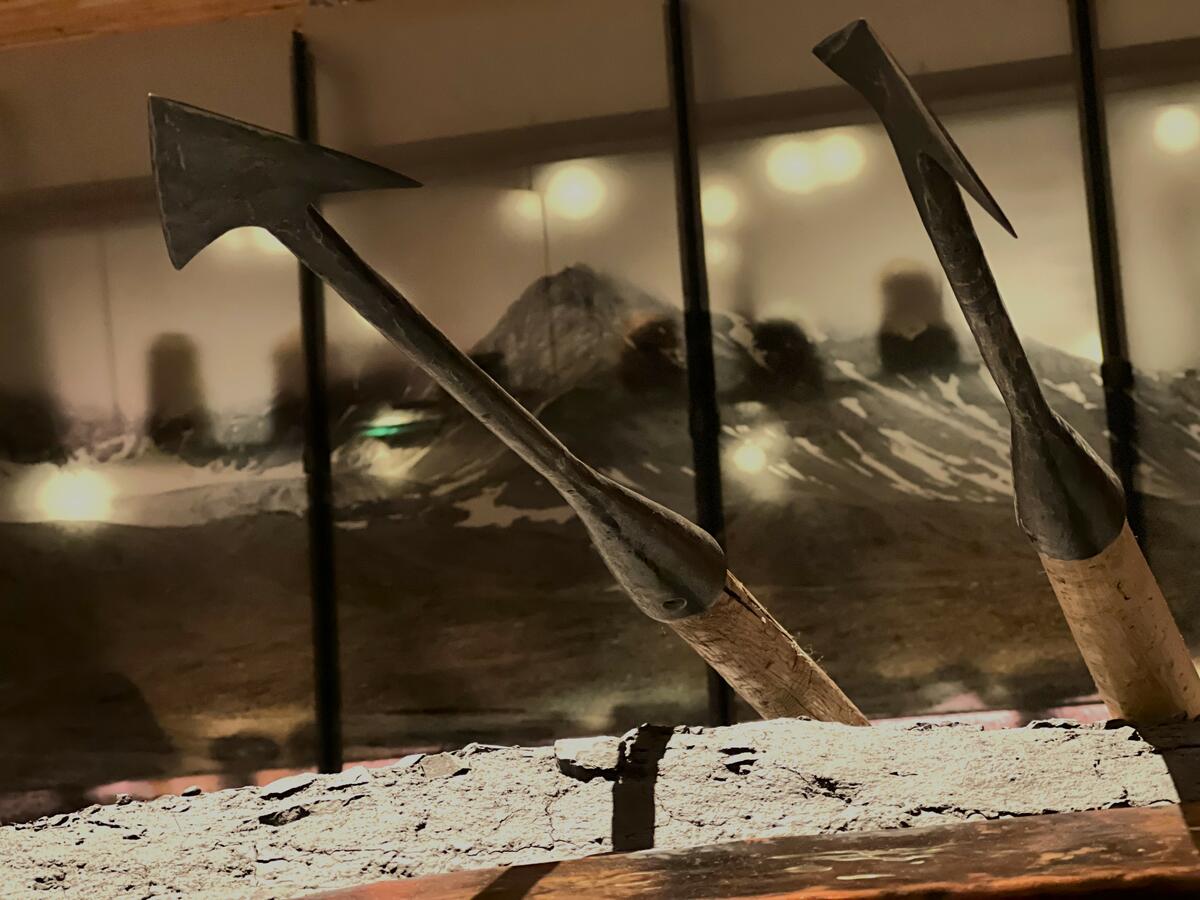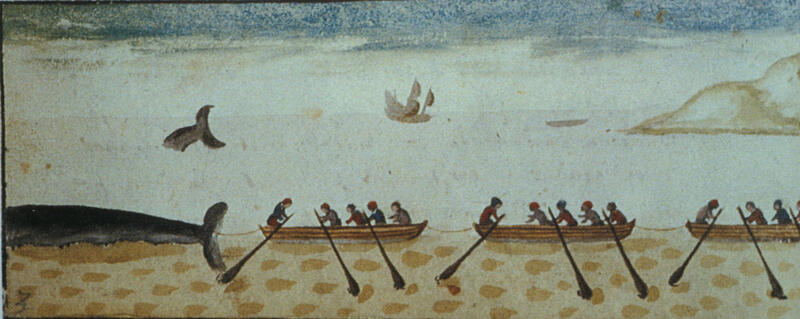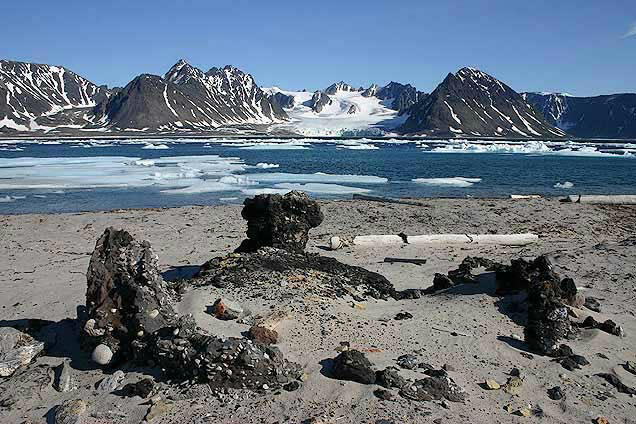- 1/1
Whaling in the 17th century. Source: Fotherby 1613
THE FIRST ‘OIL RUSH’
In the 15th century, Europe began to blossom and the countries grew strong. Internal conflicts, wars, crises, plagues, and epidemics were a thing of the past. Populations grew and moved from the countryside to the towns. In the 16th century, Europe looked out across other countries and continents, towards opportunities to trade and new goods to buy and sell. Two hundred years later, Europe is a world power. Europe’s political and economic growth forms the backdrop for whaling in Svalbard.
It all began when Spain and Portugal were Europe’s foremost seafaring nations. They found the sea route to Asia and discovered America. They had a monopoly on trade with these vast, bountiful expanses of land. But in northwestern Europe, new nations of seafarers were emerging: England, France, the Dutch Republic. They wanted a share of what Spain and Portugal had. The young seafaring nations competed for trade and markets. A northern sea route to the Far East might help them get established. This prompted systematic exploration of the northern seas.
Svalbard was discovered by the Dutchman Barentsz in 1596. In subsequent years, huge numbers of whales, seals, and walrus were reported in the archipelago. At the same time, demand for products made from whales and seals increased in Europe. Europe needed oil. The seafaring nations took note of the rich resources available up north and began learning the art of whaling. The year 1612 marks the beginning of systematic whaling in Svalbard. Seamen from many countries came to the archipelago to explore and harvest the rich natural resources. The dream of finding an eastern sea route remained, but it was no longer the primary goal. The main attractions were now Svalbard and whaling.
- 1/1
Treadmill for lifting strips of blubber. Source: Fotherby 1613
ONSHORE EXTRACTION OF WHALE OIL
Svalbard’s whaling boom is a tale of brave, adventurous men with dreams of wealth. Their everyday lives were filled with blubber and oil. After the hunt, the blubber had to be flensed and rendered to oil. In Europe, whale oil was used to make soap and in oil lamps, but also for preparation of textiles and leather. The baleen was used in ‘whalebone’ corsets and parasols.
In Svalbard around the middle of the 17th century, whales were hunted in summer near the coast and in the fjords. The industry relied on land-based whaling stations where the blubber could be rendered to whale oil in huge cauldrons called try pots.
To begin with, the whaling stations were temporary installations on the shore, with simple makeshift ovens around the try pots. The work was done in the open and the men lived in tents. Eventually the whalers built proper houses and workshops, and made trying ovens of masonry that could be used year after year.
The ships that sailed north each year brought along four to six rowboats, which were used in the actual whale hunt. Each of the rowboats had a crew of six. The harpooner sat in the prow, the helmsman sat in the stern, and there were four rowers between them. When a whale was sighted, they would row as close to it as possible. Landing a perfect hit with the harpoon was crucial. The harpoon was attached to long lines that would whip out at great speed when the harpooned whale dived. Martens (1671) described this as voyage where ‘the whale tows the boat so fast that the wind whistles in our ears’.
It was important that the line ran free. If it became entangled the rowboat could be pulled under. If the prow was not aligned with the whale’s movement, the boat could capsize. Men who fell into the icy water were unlikely to survive.
Several rowboats joined the hunt and would take turns harpooning the whale when it surfaced to breathe. Eventually, the whale would be exhausted from loss of blood and from dragging all the boats. At that point, the hunters closed in on the whale and killed it with lances. The dead whale was towed ashore or alongside the ship, where the crew would flense it, cutting loose long strips of blubber. On land, these strips were cut into ever smaller pieces on cutting tables. Ultimately, they were put into try pots on the trying ovens and the oil was rendered. The boiling whale oil was allowed to cool in cooling cauldrons filled with water, which also served to separate out any impurities. The oil was then put into barrels and casks and transported to the ship for storage until the end of the season and the journey home.
Whaling at sea and on the ice
In the mid 17th century, whales began avoiding the fjords and coastal waters of Svalbard, and whaling operations were concentrated to whaling vessels on the open sea and along the ice edge.
Whaling on the open sea led to changes in equipment, boats, and crew. Whales were captured using the same methods as for land-based whaling, but they were now captured on the open sea and flensed alongside the ship. The blubber was either rendered to oil on board, or packed in barrels and rendered when the ship returned home.
Whaling really took off at this point. Soon whaling was practiced in much the northern seas, attracting ships from most of Europe’s seafaring nations. Many more than previously participated in whaling. At the end of the 17th century, as many as two or three hundred whaling and sealing vessels could be out in the ice east of Greenland in the summer.
Svalbard lost its importance as a land base. The old whaling stations were no longer used and began to fall into disrepair. Trying ovens were taken apart, any useable materials and implements were salvaged and taken back home. Svalbard now served as a safe haven in emergencies, a gathering place for whalers at the beginning and end of the season, and as a burial site. Many sites in Svalbard harbour the graves of men who lost their lives whaling in the 17th and 18th centuries.
- 1/1
Trying oven. Photo: Arild Lyssand
THE END OF AN ERA
At the beginning of the 17th century, huge numbers of whales were reported in the waters off Svalbard. Captain Pool wrote of his voyage to Svalbard in 1612 that there were so many whales alongside the ships that they almost had to plough their way forward. At the end of the 18th century, it was all over. The bowhead whale populations east and west of Greenland suffered a tragic and fateful collapse. After years of intensive hunting, these whales had essentially been wiped out. Ships that ventured north to hunt whales returned home almost empty. The western European whaling adventure in the northern seas had come to an end.
‘So little by little they killed off the whales and they all disappeared – and winter reclaimed the land as its own.’



